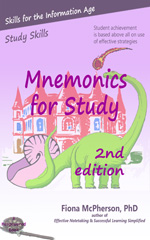Guide to Use
- To be used effectively, you need to be able to create images quickly
- To be used effectively, all steps need to be properly implemented
- They help you learn faster, not better
- They are useful for:
- learning the right order
- memorizing retrieval cues
- anchoring many details
The method of loci or place method
This is the classic mnemonic strategy, dating back to the ancient Greeks, and is (as evident from its continued use over 2500 years) an extremely effective strategy for remembering lists.
First of all, you choose a place you know very very well. Perhaps a familiar route, your house, or a particular room in it. Any place that you know well enough to easily call to mind various ‘landmarks’ (different fixed objects in a room, for example). You must train yourself to go around your landmarks in a particular order. With a route of course, that is easy.
Thus, to remember a shopping list, you simply imagine each item in turn at these landmarks. A loaf of bread sticking out of the letterbox; a giant apple in place of the door; the hall full of beans; a giant banana in the bath, etc.
Because the place method uses cues that are already well-known to you, it is probably the easiest of the imagery mnemonics to master.
Disadvantages
- difficult to recall a particular item without going through the list in order until you reach the item you want.
- most effective as a relatively short-term strategy (By using the landmarks again and again, you can only readily recall the last list. Earlier lists are much less easily recalled.)
- difficult to use if the information is presented too fast
The pegword mnemonic
uses numbers instead of places. These numbers are transformed into visual images by means of the following simple rhyme:
one is a bun
two is a shoe
three is a tree
four is a door
five is a hive
six is sticks
seven is heaven
eight is a gate
nine is a line
ten is a hen
The rhyme must be learned by rote until it is over-learned. Accordingly, there is a higher ‘cost’ to the pegword method than to the place method, where cues already over-learned are used.
Disadvantages
- most effective as a relatively short-term strategy (By using the landmarks again and again, you can only readily recall the last list. Earlier lists are much less easily recalled.)
- difficult to use if the information is presented to you too fast
- difficult to use effectively without extensive training.
Find out more about the pegword mnemonic
The link method
like the others, uses visual images to link items together. However, instead of linking items to a well-learned structure, items are linked to each other. For example, to remember our shopping list of bread, apples, beans, bananas, you would form an image of the bread interacting with apples in some way, then another image of apples and beans, then another image bringing beans and bananas together.
The story method
is the verbal equivalent of the link method. Items are chained together by linking them in a story. For example, A VEGETABLE can be a useful INSTRUMENT for a COLLEGE student. A carrot can be a NAIL for your FENCE or BASIN. But a MERCHANT of the QUEEN would SCALE that fence and feed the carrot to a GOAT.
Disadvantages of Link and Story Methods
- difficult to recall a particular item without going through the list in order until you reach the item you want.
- difficult to use if the information is presented too fast.
- difficult to use effectively without extensive training.
- Belleza, F.S. 1983. Mnemonic-device instruction with adults. In Pressley, M. & Levin, J.R. (eds.) Cognitive strategy research: Psychological foundations. New York: Springer-Verlag.
- Bower, G.H. & Reitman, J.S. 1972. Mnemonic elaboration in multilist learning. Journal of Verbal Learning and Verbal Behavior, 11, 478-485.
- Morris, P.E. 1979. Strategies for learning and recall. In M.M. Gruneberg & P. Morris (eds.) Applied problems in memory. London: Academic Press.
